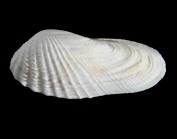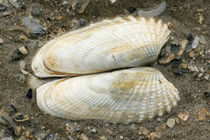
| Intro | | Search taxa | | Browse taxa | | Distributions | | Terminology | | References | | Statistics | | Online sources | | Tutorial | | Log in |
WoRMS name detailsPetricola pholadiformis Lamarck, 1818
140730 (urn:lsid:marinespecies.org:taxname:140730)
unaccepted (original combination)
Species
marine, brackish,
Lamarck, [J.-B. M.] de. (1818). <i>Histoire naturelle des animaux sans vertèbres</i>. Tome cinquième, 612 pp. Paris, Deterville/Verdière. , available online at http://biodiversitylibrary.org/page/12886879 [details]
Description A thin, fragile elongated shell up to 65 mm long. The outside of the shell is covered with ribs radiating from the top that...
Description A thin, fragile elongated shell up to 65 mm long. The outside of the shell is covered with ribs radiating from the top that are crossed by the growth lines. The ribs in the front part under the top bear clear squamous projections used to ‘bore’ through the substrate. The colour is lime white or yellowish white; older specimens are coloured brownish yellow. Bores in hard clay, limestone and solid mud as well as in pieces of peat and wood. [details] Distribution In both periods Petricola pholadiformis could only be found in the coastal zone, with a clear preference for the eastern...
Distribution In both periods Petricola pholadiformis could only be found in the coastal zone, with a clear preference for the eastern coastal zone. Although the distribution of the species was limited, high densities were observed locally: up to 500 ind./m2 in the 1976-1986 period and up to 1,000 ind./m2 in the 1994-2001 period. [details]
MolluscaBase eds. (2025). MolluscaBase. Petricola pholadiformis Lamarck, 1818. Accessed through: World Register of Marine Species at: https://www.marinespecies.org/aphia.php?p=taxdetails&id=140730 on 2025-07-15
Date action by
Nomenclatureoriginal description
Lamarck, [J.-B. M.] de. (1818). <i>Histoire naturelle des animaux sans vertèbres</i>. Tome cinquième, 612 pp. Paris, Deterville/Verdière. , available online at http://biodiversitylibrary.org/page/12886879 [details] basis of record Gofas, S.; Le Renard, J.; Bouchet, P. (2001). Mollusca. in: Costello, M.J. et al. (eds), European Register of Marine Species: a check-list of the marine species in Europe and a bibliography of guides to their identification. <em>Patrimoines Naturels.</em> 50: 180-213., available online at http://www.vliz.be/imisdocs/publications/ocrd/254404.pdf [details] Othercontext source (Introduced species)
Molnar, J.L., R.L. Gamboa, C. Revenga & M.D. Spalding. (2008). Assessing the global threat of invasive species to marine biodiversity. <em>Frontiers in Ecology and the Environment.</em> 6(9): 485-492., available online at https://www.conservationgateway.org/ConservationPractices/Marine/Pages/marineinvasives.aspx [details] Available for editors
context source (Schelde) Maris, T., O. Beauchard, S. Van Damme, E. Van den Bergh, S. Wijnhoven & P. Meire. (2013). Referentiematrices en Ecotoopoppervlaktes Annex bij de Evaluatiemethodiek Schelde-estuarium Studie naar “Ecotoopoppervlaktes en intactness index”. [Reference matrices and Ecotope areas Annex to the Evaluation methodology Scheldt estuary Study on “Ecotope areas and intactness index”. <em>Monitor Taskforce Publication Series, 2013-01. NIOZ: Yerseke.</em> 35 pp. (look up in IMIS) [details] additional source Bromley, J.E.C. & J.S. Bleakney. (1985). Keys to the fauna and flora of Minas Basin. <em>National Research Council of Canada Report, Halifax, N.S.</em> 24119: 366 PP. [details] additional source Meinkoth, N. A. (1981). Field guide to North American seashore creatures. <em>The Audubon Society.</em> 1-799. [details] additional source Ardovini, R.; Cossignani, T. (2004). West African seashells (including Azores, Madeira and Canary Is.) = Conchiglie dell'Africa Occidentale (incluse Azzorre, Madeira e Canarie). English-Italian edition. L'Informatore Piceno: Ancona, Italy. ISBN 88-86070-11-X. 319 pp. (look up in IMIS) [details] additional source Muller, Y. (2004). Faune et flore du littoral du Nord, du Pas-de-Calais et de la Belgique: inventaire. [Coastal fauna and flora of the Nord, Pas-de-Calais and Belgium: inventory]. <em>Commission Régionale de Biologie Région Nord Pas-de-Calais: France.</em> 307 pp., available online at http://www.vliz.be/imisdocs/publications/145561.pdf [details] additional source Streftaris, N., A. Zenetos & E. Papathanassiou. (2005). Globalisation in marine ecosystems: the story of non-indigenous marine species across European seas. <em>Oceanogry and Marine Biology: an Annual Review.</em> 43: 419-453. (look up in IMIS) [details] Available for editors additional source Zenetos, A., M.E. Cinar, M.A. Pancucci-Papadopoulou, J.G. Harmelin, G. Furnari, F. Andaloro, N. Bellou, N. Streftaris & H. Zibrowius. (2005). Annotated list of marine alien species in the Mediterranean with records of the worst invasive species. <em>Mediterranean Marine Science.</em> 6 (2): 63-118., available online at https://www.researchgate.net/publication/273213810_Annotated_list_of_marine_alien_species_in_the_Mediterranean_with_records_of_the_worst_invasive_species [details] Available for editors additional source Huber, M. (2010). <i>Compendium of bivalves. A full-color guide to 3,300 of the world's marine bivalves. A status on Bivalvia after 250 years of research</i>. Hackenheim: ConchBooks. 901 pp., 1 CD-ROM. (look up in IMIS) [details] additional source Rosenberg, G. 1992. <i>Encyclopedia of Seashells</i>. Dorset: New York. 224 pp. page(s): 163 [details] additional source Zenetos, A., S. Gofas, M. Verlaque, M. Cinar, J. Garcia Raso, C. Bianchi, C. Morri, E. Azzurro, M. Bilecenoglu, C. Froglia, I. Siokou, D. Violanti, A. Sfriso, G. San Martin, A. Giangrande, T. Katagan, E. Ballesteros, A. Ramos-Espla, F. Mastrototaro, O. Ocana, A. Zingone, M,. Gambi & N. Streftaris. (2010). Alien species in the Mediterranean Sea by 2010. A contribution to the application of European Union's Marine Strategy Framework Directive (MSFD). Part I. Spatial distribution. <em>Mediterranean Marine Science.</em> 11(2): 381-493., available online at https://doi.org/10.12681/mms.87 [details] additional source Johnson, C. W. (1914). <i>Petricola dactylus</i> Sowerby. <em>The Nautilus.</em> 28(12): 95., available online at https://www.biodiversitylibrary.org/page/1750554 [details] additional source Backeljau, T. (1986). Lijst van de recente mariene mollusken van België [List of the recent marine molluscs of Belgium]. Koninklijk Belgisch Instituut voor Natuurwetenschappen: Brussels, Belgium. 106 pp. (look up in IMIS) [details]  Present Present  Present in aphia/obis/gbif/idigbio Present in aphia/obis/gbif/idigbio  Inaccurate Inaccurate  Introduced: alien Introduced: alien  Containing type locality Containing type locality
From regional or thematic species database
Introduced species abundance in Dutch part of the North Sea (Marine Region) : Common [details]Introduced species impact in Belgian part of the North Sea : Other impact - undefined or uncertain [details] Introduced species impact in Celtic Sea (IHO Sea Area) : Other impact - undefined or uncertain [details] Introduced species impact in Denmark (Nation) : Other impact - undefined or uncertain [details] Introduced species impact in Germany (Nation) : Other impact - undefined or uncertain [details] Introduced species impact in Norwegian part of the Skaggerak (Marine Region) : Other impact - undefined or uncertain [details] Introduced species impact in United Kingdom part of the English Channel (Marine Region) : Damage to marine structures or archaeology [details] Introduced species impact in United Kingdom part of the North Sea (Marine Region) : Damage to marine structures or archaeology [details] Introduced species remark In United Kingdom part of the English Channel (Marine Region) : Borer [details] Introduced species remark In United Kingdom part of the North Sea (Marine Region) : Borer [details] Introduced species vector dispersal in Belgian part of the North Sea: Aquaculture: accidental [details] Introduced species vector dispersal in Norwegian part of the Skaggerak (Marine Region) : First introduced to southern England unintentionally with Crassotrea oysters. Most likely vector of introduction to Greece is ship transfer. [details] Introduced species vector dispersal in United Kingdom part of the English Channel (Marine Region) : Fisheries: accidental with deliberate translocations of fish or shellfish [details] Introduced species vector dispersal in United Kingdom part of the North Sea (Marine Region) : Fisheries: accidental with deliberate translocations of fish or shellfish [details] Introduced species vector dispersal in Belgian part of the North Sea: Aquaculture: accidental [details] Unreviewed
Description A thin, fragile elongated shell up to 65 mm long. The outside of the shell is covered with ribs radiating from the top that are crossed by the growth lines. The ribs in the front part under the top bear clear squamous projections used to ‘bore’ through the substrate. The colour is lime white or yellowish white; older specimens are coloured brownish yellow. Bores in hard clay, limestone and solid mud as well as in pieces of peat and wood. [details]Distribution In both periods Petricola pholadiformis could only be found in the coastal zone, with a clear preference for the eastern coastal zone. Although the distribution of the species was limited, high densities were observed locally: up to 500 ind./m2 in the 1976-1986 period and up to 1,000 ind./m2 in the 1994-2001 period. [details] Habitat Petricola pholadiformis is only found in fine sediments with a median grain size < 250 μm. In sediments with a median grain size of 100-150 μm a relative occurrence of 50% is even noted. The mud content seems less decisive for the habitat preference; however, the species does not occur in sediments without mud and the relative occurrence increases as the mud content of the sediment increases. [details] Habitat Known from seamounts and knolls [details] alien species The natural distribution area of the false angelwing Petricola pholadiformis was limited to the east coast of North America, but was brought to Europe (England) around 1890 together with the transport of the eastern oyster Crassostrea virginica. The planktonic larvae of the false angelwing could subsequently reach the rest of Europe by hitchhiking on the sea currents. The species was first observed in Belgian waters at Nieuwpoort in 1899. Now, the false angelwing mainly lives around our east and middle coast. This bivalve drills passageways in peat blocks, wood, hard clay and limestone. Living individuals are often found in washed ashore peat blocks. Empty shells are frequently found on our beaches. [details]
Encyclopedia of Marine Life of Britain and Ireland
European Network on Invasive Alien Species (NOBANIS) - Petricola pholadiformis Marine Life Information Network - UK To Biodiversity Heritage Library (261 publications) To Dyntaxa To GenBank (18 nucleotides; 6 proteins) To PESI To USNM Invertebrate Zoology Mollusca Collection To ITIS |


